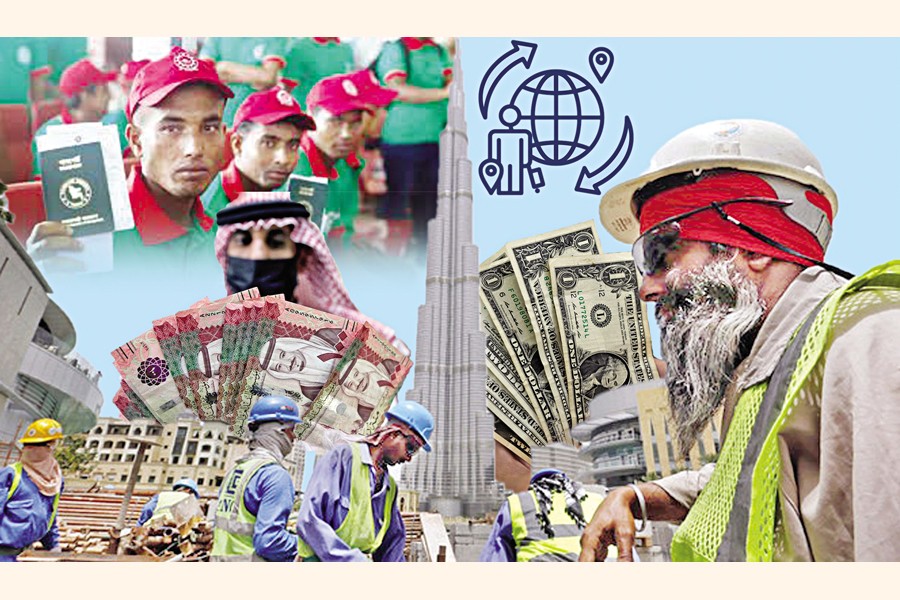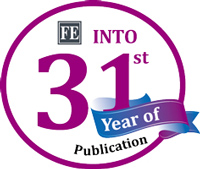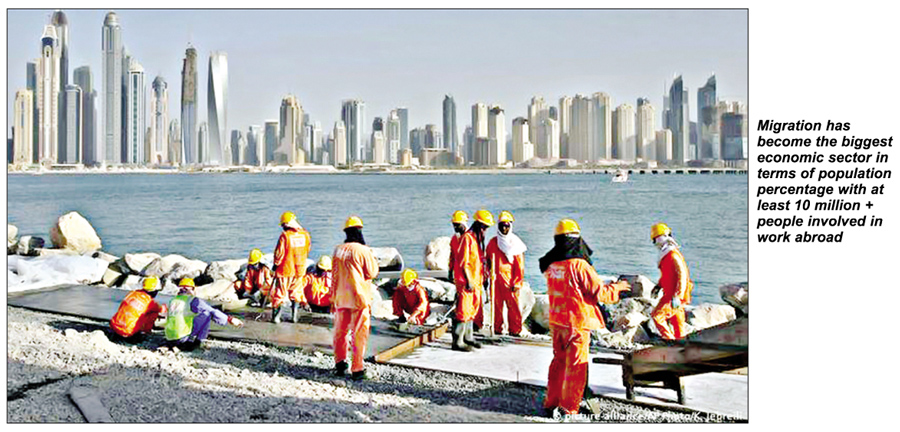
 Migration has become the biggest economic sector in terms of population percentage with at least 10 million + people involved in work abroad. While one has some idea about the migrants in the regular and proto-regular space whether in the Middle East zone or Malaysia, there are some twilight migration zones too. To an extent, regular migrants are more part of the economy using banking channels for about 50% of their remittance sent home. The rest of the money comes through hundi.
Migration has become the biggest economic sector in terms of population percentage with at least 10 million + people involved in work abroad. While one has some idea about the migrants in the regular and proto-regular space whether in the Middle East zone or Malaysia, there are some twilight migration zones too. To an extent, regular migrants are more part of the economy using banking channels for about 50% of their remittance sent home. The rest of the money comes through hundi.
However, very little is known about the size of migrants to India or Pakistan. The numbers quoted are in the range of millions particularly in case of India. No one has done any census so any number can be quoted, particularly when it suits politics. However, even by conservative estimates, it would be between 5-10 million.
Meanwhile, several reports say that around 2.0 million Bangladeshis are in Pakistan. And they are undocumented migrants so remittance has no role attached to them. These two clusters of migrants have turned into "invisible "migrants as far as Bangladesh authorities are concerned. One reason of course is that they are not remittance senders but do send money home, big or small. However, they are part of the migrant population which all put together is certainly 15 million and could be as high as 20+ million possibly.
 If the national population is approximately 170 million, we have at least 10% of the population who are not dependent on the national economy. If we include their family members - 5.0 per family -- we have about 75 million to 100 million (app) people whose income and consumption is primarily funded by foreign income. That number is close to 40% of the population. The socio-economic implications of such a configuration is another matter altogether.
If the national population is approximately 170 million, we have at least 10% of the population who are not dependent on the national economy. If we include their family members - 5.0 per family -- we have about 75 million to 100 million (app) people whose income and consumption is primarily funded by foreign income. That number is close to 40% of the population. The socio-economic implications of such a configuration is another matter altogether.
Migration therefore is not just another source of foreign exchange income as is generally understood in Bangladesh by the formal official world. They have been dubbed as "remittance warrior" by many so the essential connotation is obvious, not one encompassing at least one-third of the population. As a result policy making and implementation has been somewhat inadequate due to its conceptualization by those who matter, national and international. It's not that they haven't done much but unpacking the issues around migration, regular and irregular needs to be integrated into a more comprehensive policy.
KINDS OF MIGRATION
There are four broad categories of migration. a. economic migration. b. citizenship migration that is when people move to another land and gain another citizenship such as migrants to North America, Canada, UK etc. c. social migration; when people migrate to seek protection from oppression in their homeland. d. environmental migration which is globally now becoming common as life and livelihood are threatened by climate change and other disasters. The focus of this article is economic migration in Bangladesh.
STAGES OF MIGRATION:
It is generally known that migration is not a sudden decision but is taken over time in most cases except in cases of social migration when sudden and quick departures are common as in case of the Rohingyas. In case of economic migration the following stages are identified.
1. THE DECISION /INTENT TO MIGRATE
Several factors work in making the decision. They are both internal and external. Usually, the remittance migrants will be influenced by others in their network to decide to migrate which includes family members or fellow villagers and friends. They weigh the options in the local economy and see if they have a future better here than a migrant's income. Since migrants all earn much more than any local work, the decision is not difficult to make.
However factors that may work against the decision are a health issue in the immediate family, inability to mobilize resources to fund the migration, lack of contacts with dalals who facilitate exit or legal cases that may prevent airport exit. Otherwise, migration as a source of economic development is rarely denied.
Another source is scouting by intermediaries who peddle foreign work to possible clients. They are a major factor in influencing people to decide to migrate. However, due to lack of regulation, many would-be migrants often become "failed migrants " as they could be cheated, fail to find adequate paying work in their destination or due to other reasons are forced to return home without any savings to offset their financing to depart not to mention their general income level..
2. PREPARATIONS TO MOVE
This is the most critical part of the process as it involves organizing the funds to facilitate the journey. The commonest form is to sell landed property, usually family property. Migration is a household economic activity not an individual one. They also have to organize informal payments to a series of people that may cost a significant part of the household savings. If the migrant fails in this venture and loses the opportunity to fraud and can't stay long enough to compensate for the expenditure, entire families face financial ruin.
3. DEPARTURE
This involves organizing various documents, permissions including passports, NOCs, police clearance in some cases and normal migration documents including health checks for which intending migrants have to come to a city which exposes them to uncertainties as well.
4. ARRIVAL, ACCLIMATION AND EMPLOYMENT
Once a migrant arrives he will have some contacts and if lucky know a few long time residents. If the employer is genuine, the job will lead to prosperity but if not so, he will either work in dismal conditions, be unable to save enough money and many will be forced to return home having lost their investment. There is no protection system from the formal agencies of Bangladesh though the embassies are supposed to provide support. But given the size of the migrant population and staff capacity this is impossible. They are basically expected to take care of themselves. As a reason the net rate of those who are considered as "failed migrants" is around 30%, one of the highest anywhere.
5. REMITTANCE CONTACTS AND HOME SITUATION
Once the migrant is able to save money he sends them home. Although he uses the banking channels, he also uses hundi or informal channels. They are profitable and closer to their home. And their network is located inside the migrant society. It's at this point that they also become part of the national economic scenario as "remittance warriors"
6. FAILED AND SUCCESSFUL MIGRANTS AND SOCIO-ECONOMIC TRANSITION
The life at home differs markedly between failed and successful migrants. Failed migrants are members of the new poor in society and the successful transit to a higher level of influence and prosperity. The successful migrant has significant influence on all aspects of society including national behaviour through their upholding of traditional institutions including the clergy. They also have a significant impact on the local environment, economy, social behaviour and also facilitation of more migrants abroad. Given their population size which is over 10 million this can easily be gauged.
MIGRATION GOVERNANCE: RELEVANCE AND REPAIR
Migration Governance Framework (MIGOF) is the official governing tool of the migration sector in Bangladesh. The Migration Governance Framework was a joint effort between IOM and the Government of Bangladesh (2017).
"This framework is intended to guide the policy direction of the Government of Bangladesh and facilitate the implementation of results-based planning and reporting on the efforts and progress made towards migration governance in the country. The overall goal of the framework is to establish a mechanism to ensure safe migration."
PRIORITIES AND STRATEGY
Major priorities are: a. Official agreements with destination countries. b. Regional consultative process. immigration and Border Management. d. Comprehensive return and reintegration policy; e. remittance management policy. f. Mainstreaming Migrants in Countries of Crisis (MICIC) and Migration Crisis Operational Framework (MCOF) in Bangladesh
The strategy recommended by IOM are : a. Adopt a 'whole of government' approach in improving and strengthening overall migration governance in the country. b. Focus on incorporating migrant-centred rights based approach in policy formulation and implementation. c. Evidence based policy development in Bangladesh. d. Enhance capacity of government functionaries for better policy formulation and migration management services.
Hence the focus is on the capacity building of the GOB in this sector through the implementation of the MIGOF Bangladesh including migrant rights.
CONSULTATION ON MIGOF AND VILLAGES
A recent review of how MIGF is impacting on the state of migration at the village level was carried out. Several agencies were involved with the informal /preliminary level consultation before a national study is to go ahead. Five agencies active in the migration sector were consulted. The geranial responses are noted below:
• MIGF has had a positive impact though how much it's not known as large scale study has not been done yet. However project management experience says that service seeking by migrants and response by GOB/formal institutions have improved but it's more when institutions /NGOs are involved and not when individuals seek help.
• Both positive achievements and lack of progress are noted. Covid has impacted on the MIGOF performance too.
• Conditions have definitely improved in the last 5 years minus the Covid period but the recovery shows resilience and improvement. Many services can be accessed by would-be migrants without coming to Dhaka and increased access use of digital services is a positive.
• GOB services have significantly improved in the last 5 years including support to families such as children education of migrant families, local availability of services, responding to complaints etc. Intervention agencies particularly NGOs enhance rights access but individuals have less understanding of the process.
• The situation has improved in the last 5 years particularly in decentralization and better contact with the government' main player, central BMET. Local level training is more now and information access particularly digitally is higher.. However, organizations/intermediaries are doing this and individual accessing is still limited.
SUMMARY OF THE REPORT
Key improvements are decentralization, better access to information digitally, better complaint addressing, availability of smart cards for migration, education for children etc.
Services quality of NGOs has improved and better inter-actions noted within actors. However, one to one interactions with the GOB are not at a positive level yet.
There is little knowledge of the informal sector performance including impact of MIGOF policy on them which mentions incorporation of their role.
In view of the conversations, following sectors can be tracked on the impact of MIGOF at the village level.
WHAT IS NEEDED?
• Track the migration process from the stage of intent to successful migration to understand how various actors are performing vis-à-vis the migrant's needs.
• Identify the satisfaction and dissatisfaction level of migrants with service providers at all levels and sectors-formal, non-formal and informal players
• Examine the role of MIGOF or GOB interventions to reduce the failure rate of migrants and failed migrant rights..
• Measure capacity building initiative of the GOB, NGOs and other agencies in providing services to the migrants
• Describe the status, role and interaction of private sector players-formal and informal -in the system.
MIGRATION GOVERNANCE FRAMEWORK: THE FORMAL -INFORMAL GAP
The Migration Framework is focused on the policy direction of the Government of Bangladesh regarding migration governance to establish a mechanism to ensure safe migration. The strategy is to adopt a 'whole of government' approach, focus on incorporating migrant-centered rights based approach in policy formulation and implementation, evidence based policy development in Bangladesh and enhance capacity of government functionaries for better policy formulation and implementation.
The objective is to increase GOB capacity to manage a large but non-regulated sector. While the focus is on the formal, the documents also refer to the need to attend to the informal sector institutions. However, the existing policy framework doesn't adequately do that and is more focused on bringing the informal sector under formal control.
No research substantiates that this is possible since the migration process in the first critical stages is informal so the evidence of change has been on the secondary. It's best to recognize that this will always be a mixed formal -informal sector and intermediaries whether individuals or NGOs will always have a role to play. Given the limited capacity and evidence of efficiency, the problem is not only in performance but the general objective of the framework too.
afsan.c@gmail.com
© 2025 - All Rights with The Financial Express
